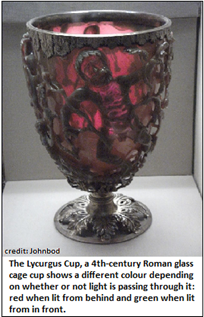Metals that target bacteria get affected too, says S.Ananthanarayanan.
Copper and silver are known bactericides. The existence of microbes, like bacteria, was not realised till the improvements in the microscope, in the 17th century. But it was known since ancient times that water stored in copper containers does not develop slime or show signs of fouling.
While we now understand that metals can be selectively toxic to bacteria, a question is what effect the bacteria may have on these metals. Giuseppe M. Paternò, Aaron M. Ross, Silvia M. Pietralunga, Simone Normani, Nicholas Dalla Vedova, Jakkarin Limwongyut, Gaia Bondelli, Liliana Moscardi, Guillermo C. Bazan, Francesco Scotognella, and Guglielmo Lanzani, from Istituto Italiano di Technologia, Politecnico di Milano, and Consiglio Nazionale delle Ricerche, at Milan, the University of California at St Barbara and the University of Singapore, describe in the journal, Chemical Physics Reviews, their work on the effect on silver, of silver’s interaction with bacteria. This understanding could even become the basis of imaging the interior of the bacteria!
Metals like copper, silver, gold, platinum, are different from metals like sodium, potassium, even iron, zinc or aluminum, on a scale of electrical activity. Thus, an electric cell with one electrode as copper and the other as zinc develops a voltage equal to the large difference in electric potential of the two metals. Metals at the copper or silver end of the scale are also less reactive, and form weak bonds with other elements, like chlorine or oxygen. They are thus easily found in nature in the metallic state, without having formed compounds. This is why gold, silver and copper were the first metals to be extracted from their ores
Metallic copper or silver can hence stay as atoms of the free metal, and if they enter living cells, or the bodies of microbes, they can be toxic. Copper and silver are hence known to be bactericides, as they are more toxic to bacteria than to humans. Copper containers have been considered naturally disinfecting and silver coins were dropped into casks of water or wine, on sea voyages, to keep the contents fresh. Knobs or railings of copper alloys or silver do not harbor microbes and silver is used in medical devices, like breathing tubes and catheters, for the same reason. Silver nitrate swabs have been used to prevent infection and battlefield wounds were wrapped in silver foil or sutured with silver thread.

As the effect of the metal on bacteria comes from individual atoms, which exist as charged ions of the element, the effect is marked when the metal is in the form of nanoparticles, which present the largest surface area. Nanoparticles of silver also display well-known optical features, changes in which have been used to monitor release of charged silver ions in different conditions and surroundings. Atoms of the metal release their outermost electrons, and these electrons move, relatively free, over the surface of the metal. Being charged particles, and influenced by the charge of the mother atoms, they move in waves, which are characteristic. As disturbance of the electrons by a light source modifies the electron wave, there are optical effects, with frequencies of light getting absorbed.
These effects were known to Roman glassmakers, who embedded silver or gold in the glass, to make goblets that would change colours when the source of light was altered. The effect was studied by the English scientist Michael Faraday in 1857 and an explanation based on scattering of light waves was developed. The current understanding, however, based on absorption by oscillation modes of free electrons, turns the property into an instrument to study how the electron cloud is affected by surrounding influences. These could be the shape of the nanoparticle, other particles in the vicinity, chemicals, or, as in the present study, microbes and bacteria.

The team writing in Chemical Physics Review carried out the study with films of silver, just 8 nanometers thick, deposited on a glass slab. A colony of the bacterium, E. Coli was grown and poured on to a base that had been treated with a nutrient. The plates with the silver film were then placed face down on the base that had the E. Coli, as well as on a base without E. Coli, as a control, and left in contact with the bacteria, or the base, for 24 hours.
The silver nanoparticles were then studied, using a high resolution, scanning electron microscope and with scattering of X-rays, to look for changes in shape. And then, with a spectroscope, to look for changes in the colours of light that the nanoparticles absorbed. And yet again, where the sample is excited by a laser pulse and probed by another pulse that rapidly follows. The images of the silver film, before exposure, show irregular nanoparticles with average thickness of 8 nm, the paper says. These stay unchanged by contact with the nutrient-enriched, control medium. Exposure to E. Coli, however, “causes dramatic changes,” the paper says. These changes were, first, of the size and shaping of the nanoparticles, with rounding of edges, and clumping together nearer the bacterial membrane and within bacteria. And then, in the nature of the electron cloud at the surface of the nanoparticles.
The use of silver nanoparticles as a bactericide has gained importance with the emergence of bacteria that are resistant to antibiotics. Knowing the mechanism of interaction of metal particles and microbes would help understand the reasons behind the nanoparticles acting on the organisms but not on human cells. This would help devise new applications and therapeutic strategies. It is challenging to study the internals of microbes while the microbes are alive. Nanoparticles that have been exposed to the microbes, however, can be examined and studied in detail. Nanoparticles could thus serve as proxies, for the study of things like bacteria, and also to detect their presence.
------------------------------------------------------------------------------------------ Do respond to : response@simplescience.in-------------------------------------------